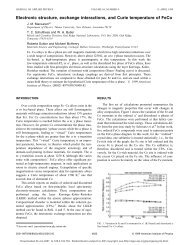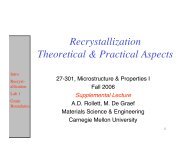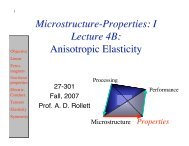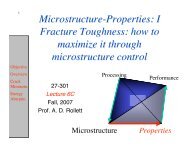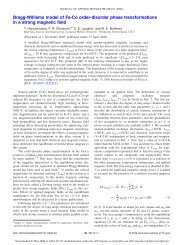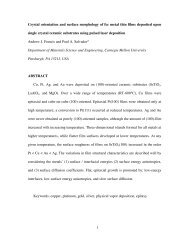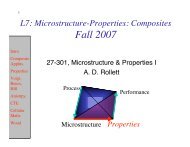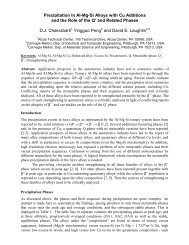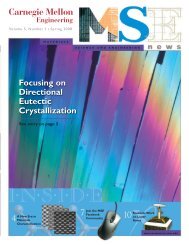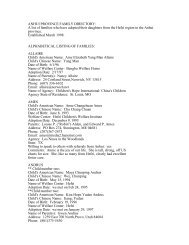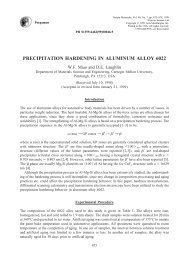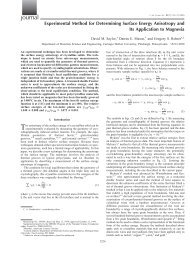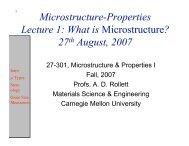popLA Manual (PDF) - Materials Science and Engineering
popLA Manual (PDF) - Materials Science and Engineering
popLA Manual (PDF) - Materials Science and Engineering
Create successful ePaper yourself
Turn your PDF publications into a flip-book with our unique Google optimized e-Paper software.
APPENDIX A – Computer Setup<br />
A1 Hardware Requirements<br />
Desktop computer: The programs are written for a PC-compatible computer (with math-coprocessor, on 386 or<br />
equivalent, or older, PCs) running DOS (version 3.3 or higher). You must have 5MB available on your C: drive<br />
to be able to install the program (plus another 400kB or so if you want LApp, the Los Alamos polycrystal<br />
plasticity simulation code, on any drive). A few of the programs (e.g., OWIMV, LApp) can be used only if you<br />
have a 386 or higher, with at least 4MB of extended memory, running under DOS 5 or higher.<br />
Monitor: This is critical only for our Polar Orientation Density (POD) program. It is written specifically for the<br />
VGA, with st<strong>and</strong>ard resolutions (480x640). You will need a minimum of 8 colors of gray shades, which works<br />
best on a 256-color monitor! Laptops with 8 or 16 “true gray shades” should first be tested.<br />
Hardcopier: A Hewlett-Packard Laserjet Series II or higher with an extra 1MB memory board is extremely<br />
desirable. Again, this is most critical for the POD program: all our area-fill graphics is written with a<br />
downloadable font for the Laserjet, <strong>and</strong> it works very fast. We also give you the option to produce a PostScript<br />
file, which you may use on other printers; it is slow. All the curve-plotting we do uses commercial drivers<br />
designed for the Laserjet (<strong>and</strong> some HP plotters, with possible conversion to the Laserjet).<br />
A2 Software Requirements<br />
The way your PC responds is governed by two files, in the versions that are active when you (re-)boot:<br />
CONFIG.SYS <strong>and</strong> AUTOEXEC.BAT.<br />
Memory <strong>and</strong> CONFIG.SYS<br />
Some of the programs need 540kB usable RAM. If you run CHKDSK, the last number tells you how much<br />
“free memory” you have. If it is not enough, eliminate unnecessary instructions from your CONFIG.SYS (such<br />
as the shell). For this reason, some programs will not run in the DOS window of WINDOWS. Also, you may<br />
have to make sure that nothing is running in the background, such as a terminal emulator or the Norton<br />
Comm<strong>and</strong>er. We do not use a mouse.<br />
The CONFIG.SYS file must contain sufficient BUFFERS for the menu to run fast. It also should contain, if<br />
possible, at least a memory manager that keeps as much as possible out of "lower memory" (the 640 KB RAM).<br />
The programs labeled "386" (including LApp) need an extended memory manager that is compatible with<br />
Lahey's executable files. If all else fails, install merely<br />
DEVICE=C:\DOS\HIMEM.SYS<br />
DOS=HIGH,UMB<br />
in CONFIG.SYS <strong>and</strong> reboot, for the time you need to use these programs.<br />
It is very h<strong>and</strong>y to have a print spooler. There are various commercial products that need installation either in<br />
CONFIG.SYS or in AUTOEXEC.BAT.<br />
Paths <strong>and</strong> AUTOEXEC.BAT<br />
Any AUTOEXEC.BAT file already contains a PATH statement. It must be augmented by<br />
;C:\X<br />
This allows for executable <strong>popLA</strong> files (ending on .EXE or .BAT) that are stored on C:\X to be used from any<br />
(sub)directory on any drive.<br />
A difficult question is the use of "appended paths". We used to recommend that you use one, by inserting the<br />
line, in AUTOEXEC.BAT, after the PATH:<br />
APPEND C:\X /path:on<br />
This allows even non-executable <strong>popLA</strong> files (such as those ending on .SYM or .WTS, etc., or those having no<br />
extension, such as PODIN), which are stored in C:\X, to be used from anywhere.<br />
However, some newer DOS programs as well as Windows may misbehave, <strong>and</strong> it is currently recommended<br />
by Microsoft to delete all APPEND statements. Two alternatives exist. One is to copy all the non-executable<br />
files you need for a particular project from C:\X into your current subdirectory. In particular, this must be done<br />
when some of John Kallend’s properties calculations on p.7 are used.<br />
The other option is to explicitly state the full path name in answer to any query for a file. All the common<br />
filenames should now have been dimensioned long enough, within the programs, to allow for this procedure. It<br />
is the first recourse when a programs says, “Can’t find that file”, or something to that effect.<br />
(Note that data file names are restricted to 12 characters: you must work in your data directory.)<br />
APPENDICES 36



